Spoiler Warning: There may be a few spoiler type things in this weeks blog...just wanted to let you all know...nothing to major, but in case you want to watch the show completely spoiler free you may want to just skim this week's entry!
Today: Monday October 23, 2006
Tonight episode 5 airs, and we get to find out what "Future Hiro's" message to Peter is...I'll say this, it is going to drive our characters for the next many episodes.
Episode 5 continues the tradition of yet-another-great-script. There is particularly great stuff with Hiro and Ando wandering the desert a la R2-D2 and C-3PO...And Nathan's first spontaneous flight (courtesy of escaping capture by HRG and the Haitian). We also get to see new characters cross in fun and unexpected ways. I personally love when Hiro and Nathan bump into each other in the desert diner. Adrian's reactions to the seemingly crazy Hiro are sooo funny. Nathan/Nikki (or is it Nathan/Jessica???) is pretty sexy too - dont'cha think?
I have new and ongoing respect for Masi Oka. When I first heard that future Hiro was coming to give Peter a message and that he'd be wearing black leather and carrying a sword and wearing a goatee - It sounded cool, but I was worried. Worried that it would be corny and that Masi might not be able to pull it off.
As I watched the scene unfold on set, I grew a new respect for Masi - he brought a great dignity and pathos to the character and I fully believed him. What I've learned about Masi since is that he's a deeply methodical actor. All of his actions and behaviors are carefully thought and grounded in truth. So whether he's pain-filled Future Hiro or goofy Hiro in the diner going "beep-beep" when he asks for a ride, his behavior is grounded. As the (as-yet-unaired) episodes progress Masi's range gets tested more and more as he encounters tragedy and (yes possibly) romance. So far he has delivered in all cases.
One of the things that makes HEROES fun and challenging to direct is the many varieties of tones that have to be blended together in each and every episode. We swing from comedy, to spooky almost-horror movie scary, to action, to realistic drama. Each scene needs to be shot and performed in subtly different ways, and yet with unifying rules that make it all feel like one show.
Allan Arkush and I have been with the show as director-producers since May, while the first scripts where being written...And have been heavily involved in participating in the conception of the visual and performance style of the show.
Directing an episode, especially of this show, is an exhausting experience. Sort of like running a sprint for 10 or 11 days. Because Allan and I have to prep, edit and oversee many aspects of the show - in the end we will only be able to personally direct 5 or 6 episodes of the show each.
So beginning with episode 4 we will start having a series of visiting directors. These directors come in for one shot at a time - and while guided to some degree by the producers, writers, and myself - they are absolutely in charge of the shooting and performance direction of their episodes. I don't know why TV is this way, it would perhaps make more sense to have a set of 3 or 4 in-house directors who rotate the direction of all the episodes. But this is not how televison evolved. The in-house producer/director job, which Allan & I have, is a relatively new phenomenon. "X-FILES" was the first show I remember that had the position. Since then it has become more common. But usually there is only one.
Even though every show has the same writers, actors and crew, without question each director brings their own style and personality to their episodes. The other thing that's good and important about having visting directors is that they are the ONLY person who is focused only on that episode. Every other writer, producer and even the crew is thinking about multiple episodes - but not the director.
Tim Kring's system is that there is always a writer on set to oversee that the performances and dialogue are getting on film in the right way. But I try to also keep up with the filming day - and especially with the prep of the episode. The rule of thumb is "good script - good prep - good episode." In many ways, how you prepare to shoot a film is when the majority of critical decisions are made. Once you're actually shooting, ideally, you've got a map of what you intend to do. If most of the key logistical decisions are planned out, it leaves more room for the kind of spontaneity (of performance, of shooting) which is, I think, where the real magic comes in. Considering that "Heroes" is a new show and a big show - other than a little unplanned overtime and some hairstyles that producers weren't happy with, we have been pretty well prepared. At least we haven't had that many out-and-out disasters.
Episode 5 was being directed by Paul Shapiro (http://www.imdb.com/name/nm0788610/)
Paul directed many episodes of SMALLVILLE, where I know him from. He has a great eye for composition. He also has a way of staging things so that, if two actors are in a scene, he'll stage them so they're both facing camera. At first, on SMALLVILLE, this drove me crazy. My own style is more about moving the camera and the actors so that the actors move into frontal shots at critcal moments. I argued with him about it at first, but then I started to see how it worked and that there was a way to make it feel natural. It allows the audience to see both actor's emotions simultaneously while keeping them separate from each other. It also allowed the lighting to be really beautiful. When your moving the actors all over the set and swinging the camera around everywhere, as I always do, there's no place for the DP to hide the lights. But when you play the actors "North-South" as Paul calls it (i.e. to and from camera) the DP can light from the sides and make it extra pretty.
Anyway, I stole the technique and now it is a staple on SMALLLVILLE. In fact, at this point when blocking the scenes in SMALLVILLE, the directors or DP's will use shorthand and say "Okay we're going to 'Shapiro' this part of the scene." Meaning both actors play out.
The day before filming begins, we take all of the department heads on a "Tech Scout" - it's the film equivilant of a technical rehersal in theatre. We visit all of the locations and sets we'll be filming on and discuss, sometimes shot-by-shot, how we'll shoot there.
Now, remember, shooting never stops on a TV show - so while the Director of Photography, Prop master, Location Manager, Gaffer (i.e. "the guy who makes the light" and the Key Grip (i.e. "the guy who makes the shadows) are spending all day talking about how we shoot the next episode - they've all left deputies in their stead to film the current episode.
TV is a crazy business, sometimes I truly wonder how we get anything on the air at all.

The tech scout begins - Our luxury bus

Paul Shapiro - Director of Episode 5
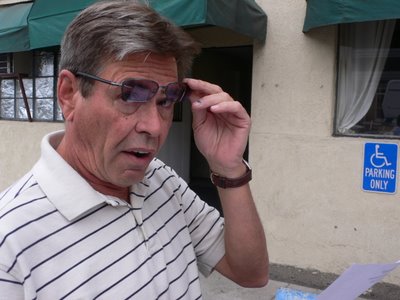
Pat Duffy - Assistant Director (i.e. the guy who schedules the episode & runs the set)
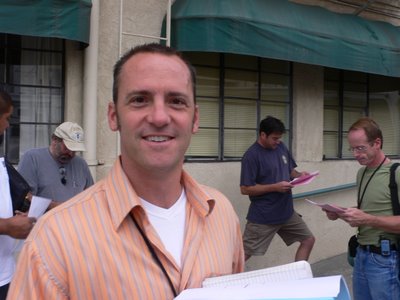
Alex Reid - Location Manager (i.e. he finds and manages all the places we shoot)

John Aronson - Director of Photography (i.e. he oversees all aspects of photography of the show)
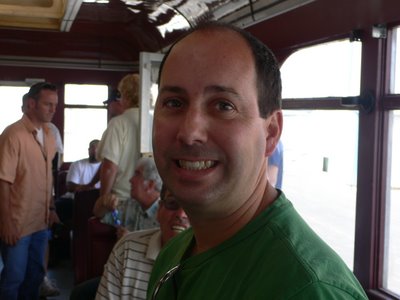
Mark Kolpack - VFX Supervisor (i.e. he's in charge of visual effects)

Scouting Niki's House

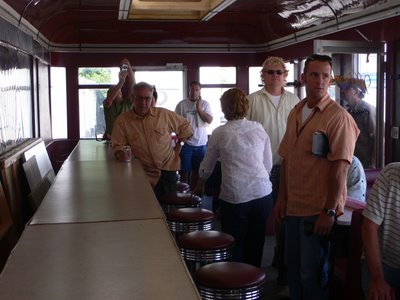
Scouting the diner - we'll pick up and move the whole thing
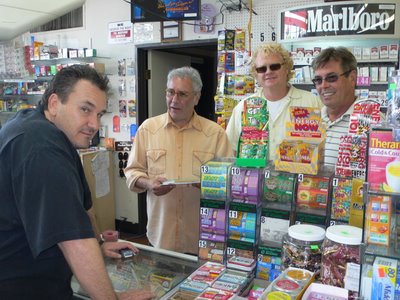
Me and the gang scouting the convenience store
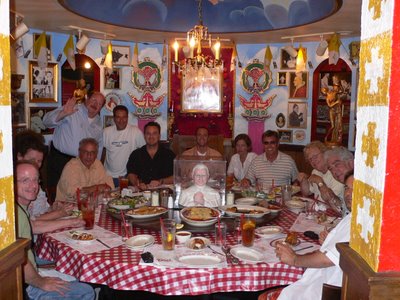
Yet another scout lunch - I'm thinking of borrowing this place's subtle use of design and color for the show
That's it for this week. Next week, an episode I directed. A very performance-intensive project for Ali Larter, and I'm thinkking of focusing on the relationship of the actor and director and performance direction in film.
Hope you like tonight's show!
GB
P.S. One last thing - people keep asking what does HRG mean...I'll give you a clue...It stands for something that is a trademark aspect of his look.
Today: Monday October 23, 2006
Tonight episode 5 airs, and we get to find out what "Future Hiro's" message to Peter is...I'll say this, it is going to drive our characters for the next many episodes.
Episode 5 continues the tradition of yet-another-great-script. There is particularly great stuff with Hiro and Ando wandering the desert a la R2-D2 and C-3PO...And Nathan's first spontaneous flight (courtesy of escaping capture by HRG and the Haitian). We also get to see new characters cross in fun and unexpected ways. I personally love when Hiro and Nathan bump into each other in the desert diner. Adrian's reactions to the seemingly crazy Hiro are sooo funny. Nathan/Nikki (or is it Nathan/Jessica???) is pretty sexy too - dont'cha think?
I have new and ongoing respect for Masi Oka. When I first heard that future Hiro was coming to give Peter a message and that he'd be wearing black leather and carrying a sword and wearing a goatee - It sounded cool, but I was worried. Worried that it would be corny and that Masi might not be able to pull it off.
As I watched the scene unfold on set, I grew a new respect for Masi - he brought a great dignity and pathos to the character and I fully believed him. What I've learned about Masi since is that he's a deeply methodical actor. All of his actions and behaviors are carefully thought and grounded in truth. So whether he's pain-filled Future Hiro or goofy Hiro in the diner going "beep-beep" when he asks for a ride, his behavior is grounded. As the (as-yet-unaired) episodes progress Masi's range gets tested more and more as he encounters tragedy and (yes possibly) romance. So far he has delivered in all cases.
One of the things that makes HEROES fun and challenging to direct is the many varieties of tones that have to be blended together in each and every episode. We swing from comedy, to spooky almost-horror movie scary, to action, to realistic drama. Each scene needs to be shot and performed in subtly different ways, and yet with unifying rules that make it all feel like one show.
Allan Arkush and I have been with the show as director-producers since May, while the first scripts where being written...And have been heavily involved in participating in the conception of the visual and performance style of the show.
Directing an episode, especially of this show, is an exhausting experience. Sort of like running a sprint for 10 or 11 days. Because Allan and I have to prep, edit and oversee many aspects of the show - in the end we will only be able to personally direct 5 or 6 episodes of the show each.
So beginning with episode 4 we will start having a series of visiting directors. These directors come in for one shot at a time - and while guided to some degree by the producers, writers, and myself - they are absolutely in charge of the shooting and performance direction of their episodes. I don't know why TV is this way, it would perhaps make more sense to have a set of 3 or 4 in-house directors who rotate the direction of all the episodes. But this is not how televison evolved. The in-house producer/director job, which Allan & I have, is a relatively new phenomenon. "X-FILES" was the first show I remember that had the position. Since then it has become more common. But usually there is only one.
Even though every show has the same writers, actors and crew, without question each director brings their own style and personality to their episodes. The other thing that's good and important about having visting directors is that they are the ONLY person who is focused only on that episode. Every other writer, producer and even the crew is thinking about multiple episodes - but not the director.
Tim Kring's system is that there is always a writer on set to oversee that the performances and dialogue are getting on film in the right way. But I try to also keep up with the filming day - and especially with the prep of the episode. The rule of thumb is "good script - good prep - good episode." In many ways, how you prepare to shoot a film is when the majority of critical decisions are made. Once you're actually shooting, ideally, you've got a map of what you intend to do. If most of the key logistical decisions are planned out, it leaves more room for the kind of spontaneity (of performance, of shooting) which is, I think, where the real magic comes in. Considering that "Heroes" is a new show and a big show - other than a little unplanned overtime and some hairstyles that producers weren't happy with, we have been pretty well prepared. At least we haven't had that many out-and-out disasters.
Episode 5 was being directed by Paul Shapiro (http://www.imdb.com/name/nm0788610/)
Paul directed many episodes of SMALLVILLE, where I know him from. He has a great eye for composition. He also has a way of staging things so that, if two actors are in a scene, he'll stage them so they're both facing camera. At first, on SMALLVILLE, this drove me crazy. My own style is more about moving the camera and the actors so that the actors move into frontal shots at critcal moments. I argued with him about it at first, but then I started to see how it worked and that there was a way to make it feel natural. It allows the audience to see both actor's emotions simultaneously while keeping them separate from each other. It also allowed the lighting to be really beautiful. When your moving the actors all over the set and swinging the camera around everywhere, as I always do, there's no place for the DP to hide the lights. But when you play the actors "North-South" as Paul calls it (i.e. to and from camera) the DP can light from the sides and make it extra pretty.
Anyway, I stole the technique and now it is a staple on SMALLLVILLE. In fact, at this point when blocking the scenes in SMALLVILLE, the directors or DP's will use shorthand and say "Okay we're going to 'Shapiro' this part of the scene." Meaning both actors play out.
The day before filming begins, we take all of the department heads on a "Tech Scout" - it's the film equivilant of a technical rehersal in theatre. We visit all of the locations and sets we'll be filming on and discuss, sometimes shot-by-shot, how we'll shoot there.
Now, remember, shooting never stops on a TV show - so while the Director of Photography, Prop master, Location Manager, Gaffer (i.e. "the guy who makes the light" and the Key Grip (i.e. "the guy who makes the shadows) are spending all day talking about how we shoot the next episode - they've all left deputies in their stead to film the current episode.
TV is a crazy business, sometimes I truly wonder how we get anything on the air at all.

The tech scout begins - Our luxury bus

Paul Shapiro - Director of Episode 5

Pat Duffy - Assistant Director (i.e. the guy who schedules the episode & runs the set)

Alex Reid - Location Manager (i.e. he finds and manages all the places we shoot)

John Aronson - Director of Photography (i.e. he oversees all aspects of photography of the show)

Mark Kolpack - VFX Supervisor (i.e. he's in charge of visual effects)

Scouting Niki's House


Scouting the diner - we'll pick up and move the whole thing

Me and the gang scouting the convenience store

Yet another scout lunch - I'm thinking of borrowing this place's subtle use of design and color for the show
That's it for this week. Next week, an episode I directed. A very performance-intensive project for Ali Larter, and I'm thinkking of focusing on the relationship of the actor and director and performance direction in film.
Hope you like tonight's show!
GB
P.S. One last thing - people keep asking what does HRG mean...I'll give you a clue...It stands for something that is a trademark aspect of his look.
Comments